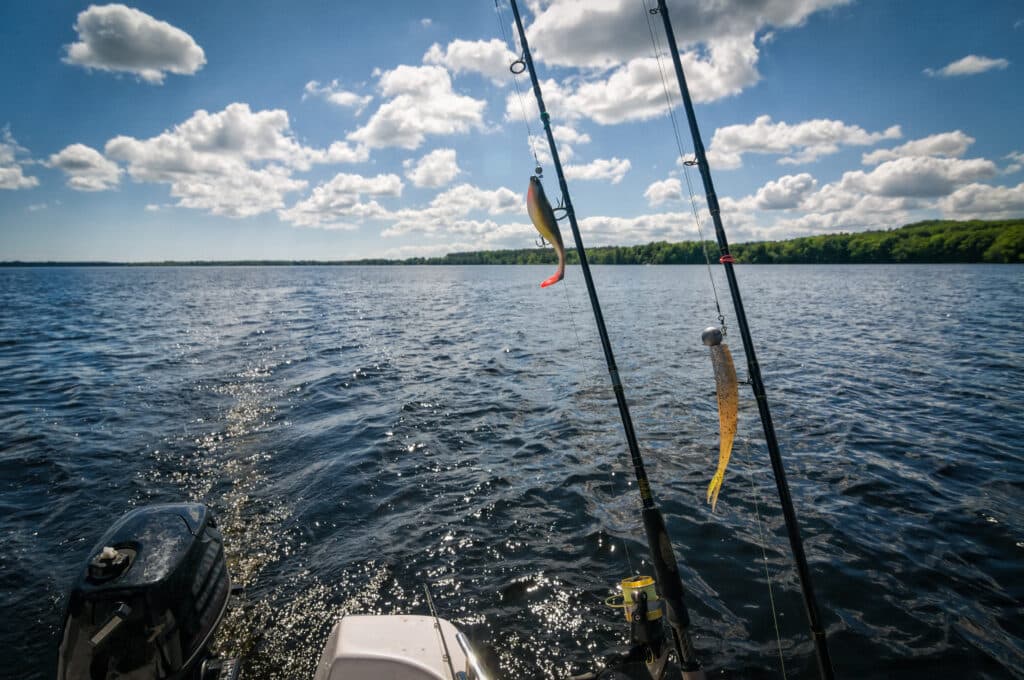Most bass anglers out there know the value of a proper entry of your lure for the best results in bass fishing.
This is especially the case when you are fishing in shallow cover.
You need to have the best entry not to scare the fish away.
Flipping is not difficult, but you need to get used to the motions.
This is a simple forward push with the rod hand.
At the same time, the non-casting hand will grab the line about one foot above the reel with a backward motion.
As soon as the casting hand with the rod is fully extended and bent downward, the other hand comes forward and inserts the lure.
It may seem confusing, but keep reading for all the steps involved with flipping a jig with a baitcaster.
You will find that no matter what type of cover you fish in, it is good practice to use the right flip bait.

Contents
Instructions On How To Flip a Jig
Let’s take a closer and in-depth look into how to execute the jig flipping in the best possible manner to make the lure entry.
This is great for anglers who are serious about bass fishing and want to outwit those types of fish.
- The first thing you need to do is to get into position and point the rod in the direction where you want to enter.
- Now hook the line about one foot in front of the reel, below the first guide. Just hook it lightly; do not grab the line.
- Now push the rod forward with your rod arm in the direction where you want to drop the lure.
- At the same time, move the non-casting hand backward with the line hooked in your hand.
- By the time your left hand is completely stretched at the back, you will have about five feet of line to play with.
- When your casting arm is fully extended, drop the tip of the rod down, so the handle at the back is above your arm.
- The moment your right arm or casting arm is fully extended and the rod tip is lowered, bring to the left arm with the line in it forward.
- At the same time to arm with the rod in it must come back just a little bit while the non-casting arm comes forward.
- At this point, when the lure comes forward because of the non-casting hand movement, the lure will make a gentle entry.
- It is important that the lure must enter the water smoothly without a splash, so it does not spook the fish away.
- This way, you can basically put the lure on the head of the bass, and it will instinctively go for the bait.
- Keep in mind that the action between the right and left arm should be smooth and in unison, with a two-handed rhythm.
It would be best if you practiced the two-handed movement outside the water until you get jig flipping right and in a smooth action.
To see the full instructions for jig flipping in action, look at this YouTube video to make it a bit easier to understand.
When Should You Flip?
The best time to use the flipping technique is when you cannot place the lure with standard casting.
It is especially handy when fishing for bass in heavy cover or shallow water conditions.
It is also ideal to use when fishing for bass in heavy grass beds, overhanging branches, or flooded bushes.
If you are fishing from boat docks, you can use this method to precisely place the lure.
Fishing for bass in small spaces is not always easy with normal casting, which makes it hard to implement true flipping.

Improving Your Flipping
Suppose you have been fishing for bass before you know they can be found in shallow water.
You also know that if you fish in cold water, the bass will go deeper, but that is only in clear water conditions.
Flipping is a technique that can be used where the water is not that deep, so the bass can not go down.
To make it a bit easier, you can use a proper fishing stick, anything between seven and eight feet.
The longer eight-foot stick gives you more line to make a much quieter entry of the lure.
The best reels used for the flipping method come included with a flipping switch for instant reeling action when the fish bites.
The switch or thumb control on the reel is pressed down with the thumb, and when it is released, it will instantly engage the reel.
This means that you do not need to use your hands for reeling. It will engage when you release the thumb bar to save time.
What Is the Difference Between Flipping And Pitching?
Some people use the term pitching when they mean flipping and the other way around when they talk about flipping.
These two techniques are not the same, but they may have the same purpose in mind, which is the precise placing of the lure.
They are both popular methods used by bass anglers and are quite effective in tight spots and boat fishing.
Pitching
Pitching is an efficient and fast way to get the lure in front of the fish that live in thick and heavy cover.
When pitching, accuracy is as important as it is with flipping. You are casting to a target point and not just swinging.
With pitching, you use short casting of the bait to land in the precise spot where you want it.
Pitching allows for a much higher landing ratio to pull out the fish as fast as possible out of thick cover.
It allows you to target fish further away from you as you move through a certain area where you know the fish is.
The bait will travel much farther if you pitch harder while you are still more or less on target.
You can see on the Youtube video that pitching uses just the casting arm when you go for the target area.
It is even easier to pitch than to flip, especially if you want to go to tight spot areas where the fish is hiding.
Unfortunately, pitching is not as accurate as the flipping technique, but you can cast a bit further away from you.
Flipping
In flipping, you use the bait’s momentum and the rod’s swing to place the lure close to the fish.
You also want to make a more gentle entry so the fish will not get spooked and move further away.
This method will also help you cover a larger area as quickly as possible while you keep the target close.
The lay-downs and thick grass edges can be targeted with this method, which wastes time for traditional casters.
Flipping also allows for swift presentations and multiple catches in a very short time before the fish move on.
Conclusion
Both flipping and pitching are great methods to use if you are fishing for bass in shallow conditions and tight spots.
Flipping is more accurate; you can easily land the gear in precise places and it is quite easy to get used to it.
Hopefully, this will help you understand and apply in your fishing for much better results.







